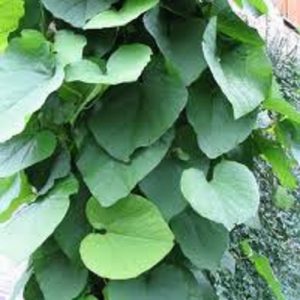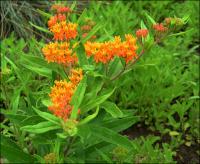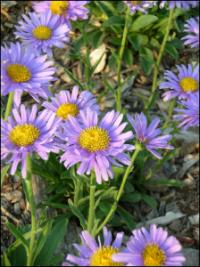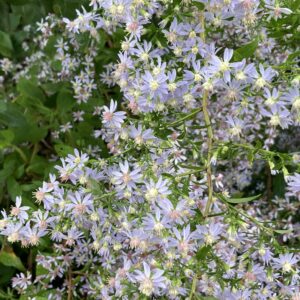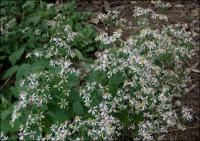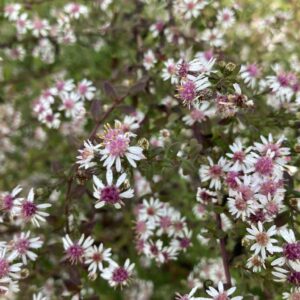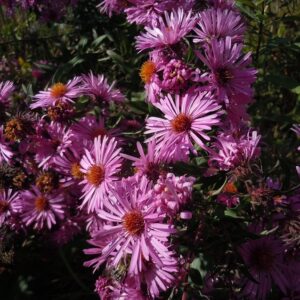Black Walnut Tolerant
Showing 9–16 of 106 results
-
Aristolochia durior syn. A. macrophylla, A sipho Dutchman’s pipe, Birthwort Z 4-8
Yellow, mottled brown flowers like Meerschaum pipes in May – June, mostly grown for heart-shaped leaves on this vigorous climber (climbs by twining). Perfect for creating a screen on pergolas, arbors and fences.
OUT OF STOCK
Yellow, mottled brown flowers like Meerschaum pipes in May – June, mostly grown for heart-shaped leaves on this vigorous climber (climbs by twining). Perfect for creating a screen on pergolas, arbors and fences.
Size: 20-30’ x 2’ at ground, 20’ on top.
Care: sun to shade (one of few vines for shade) in moist well-drained to moist soil. Prune to encourage branching.
Native: Maine to Georgia, west to KS.
Wildlife Value: sole host for the Pipevine swallowtail butterflyAristolochia is Greek for easing childbirth. Cherokee applied decoction of root for swollen legs & feet. Collected by Colonial nurseryman John Bartram and sent to England in 1763. Sold in America’s 1st plant catalog, Bartram’s Broadside, 1783. In Colonial and Victorian gardens, popular vine to create privacy and shade
-
Asarum canadense syn. Hexastylis canadense Wild ginger Z 3-7
Concealed brown bell-shaped flowers with flared tips hide under this groundcover's crinkled, lacquered leaves.
Concealed brown bell-shaped flowers with flared tips hide under this groundcover’s lacquered leaves.
Size: 6" x 6" spreading
Care: part shade to shade, moist well-drained to well-drained soil
Native: Canada to So. Carolina, Wisconsin nativeNative Americans used Wild ginger for such diverse purposes as flavoring food, curing heart palpitations, induce menstrual cycles, cure “the bite of the serpent,” mend broken bones, as a general tonic, a tea and lure catfish. Winnebago tenderized raccoon meat with this. Colonists used the plant to break fever and stimulate the appetite. Studies in the last 50 years have showed that the roots contain antibiotics BUT also can damage kidneys and are possibly carcinogenic.
-
Asclepias tuberosa Butterfly weed, Pleurisy-root Z 4-9
Gorgeous - July - September bright orange cymes
OUT OF STOCK
Gorgeous – July – September bright orange cymes
Size: 2-3' x 12"
Care: Sun in well-drained to moist well-drained soil
Native: East and south North America, Wisconsin native
Wildlife Value: Host for Monarch caterpillars and its nectar is a favorite for 13 different butterflies: 4 Swallowtails, 2 Fritillaries, Checkered white, Spring azure, Small copper, Sachem, Monarch, and Coral and Gray hairstreaks. Attracts Ladybugs that eat many insect pests.
Awards: Great Plants for Great Plains; Perennial Plant Assn. Plant of the Year 2017.Named after Asclepias, a Greek god of medicine. Omaha Indians ate the raw root to cure bronchial and pulmonary ailments, their Shell Society was the authorized guardian of the plant, taking 4 days to dig, prepare and distribute the root. Most important medicine for Menominee Indians. The Iroquois smashed roots on legs to impart strength to runners. Navajo cured coyote bites and flu with Butterfly weed. HoChunk placed masticated root into wounds. Collected and sent to England by Rev. John Banister in colonial Virginia c. 1680. Cultivated by Jefferson. Pressed specimen in Emily Dickinson’s herbarium.
-
Aster alpinus Alpine Aster Z 5-7
Frilly little daisies, May-June, lavender, pink or white
Frilly little lavender daisies, May-June. Plant where they will be seen in the front of the garden.
Size: 6" x 12"
Care: Full sun well-drained soil.
Native: Rockies
Wildlife Value: attract butterflies
Awards: England’s Royal Horticultural Society Award of Merit.
Size: Border/Rock gardensAster means star, referring to the flower’s form. Listed in Philip Miller’s Gardeners’ Dictionary 1768: “Grows naturally upon the Alps… at the top of each stalk is one large blue flower…this flowers in June…”
-
Aster cordifolius syn. Symphyotrichum cordifolium Blue wood aster Z 3-8
Heart-shaped foliage smothered with blue daisies from late summer into fall, perfect companion for anemones.
Heart-shaped foliage smothered with blue daisies from late summer into fall, perfect companion for anemones.
Size: 2-3' x 2-3'
Care: Sun to full shade in moist well-drained to dry soil
Native: Canada to Florida, west to Oklahoma, Wisconsin native
Wildlife Value: Aster species are nectar sources for many butterflies – Checkered white and Checkered skippers, Spring azure, Pearl crescent, Buckeye, Painted lady, Fiery skipper, Sachem, Sleepy orange, Silver-spotted skipper and Monarch.Aster means star, referring to the flower’s form. Winnebago used this in the sweat bath. 1st described by French botanist Jacques Philippe Cornut in 1635. Likely collected and transported from Canada to France by Samuel de Champlain. Grown in Jardin du Roi in Paris.
-
Aster divaricatus syn. Eurybia divaricatus White wood aster Z 4-8
Loose white corymbs blooming from August to October
Loose white corymbs blooming from August to October
Size: 12" x 12" and spreading
Care: part shade to shade in moist well-drained to dry soil.
Native: East No. America Quebec to Alabama and west to Ohio
Wildlife Value: Aster species are nectar sources for many butterflies – Checkered white and Checkered skippers, Spring azure, Pearl crescent, Buckeye, Painted lady, Fiery skipper, Sachem, Sleepy orange, Silver-spotted skipper and Monarch.
Awards: Recipient Great Plant Pick Award from Elizabeth Carey Miller Botanical Garden.Aster means star, referring to the flower’s form. Collected by Philadelphia nurseryman John Bartram before 1776. Sold in America’s 1st plant catalog, Bartram’s Broadside, 1783. Gertrude Jekyll, mother of the perennial border, often used Aster divaricatus in combination with Bergenia.
-
Aster laterifolius ‘Horizontalis’ syn Symphyotrichum laterifolius ‘Horizontalis’ Horizontal Calico Aster Z 4-8
Unique horizontally branching aster covered in small pink and white daisy-like flowers with dark pink centers blooming in late summer-fall. Foliage turns copper/purple in fall.
OUT OF STOCK
Unique horizontally branching aster covered in small pink and white daisy-like flowers with dark pink centers blooming in late summer-fall. Foliage turns copper/purple in fall.
Size: 24” x 24”
Care: full sun to part shade in well-drained soil
Native: Eastern and Central North America
Wildlife Value: attracts bees and butterflies. Deer resistant, Black walnut resistant.
Awards: RHS Award of Garden MeritFirst described by French botanist René Desfontaines (1750-1802). Harvard botanist Asa Gray named the variety in 1895.
-
Aster novae angliae syn. Symphyotrichum New England Aster Z 4-8
August – October, classic violet, pink or magenta daisies
August – October, classic violet, pink or magenta daisies
Size: 3-4' x 24"
Care: Full sun dry to moist soil. Heat and drought tolerant.
Native: Vt to Alabama, west to N. M., Wisconsin native
Wildlife Value: Nectar source for many butterflies - Checkered white and Checkered skippers, Spring azure, Pearl crescent, Buckeye, Painted lady, Fiery skip butterfly, Sachem, Sleepy orange, Silver-spotted skipper and Monarch. Host for caterpillars Wavy-lined emerald moth.Aster means star, referring to the flower’s form. For the Cherokee New England aster tea cured fevers and diarrhea. Roots remedied pain and inflammation of the nose and throat. Introduced to garden cultivation by John Tradescant the Younger (1608-1662) in 1637 when he sent it to England where upon borders of New England aster became common. Washington grew New England Aster at Mount Vernon.

